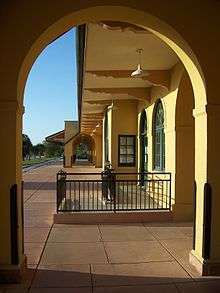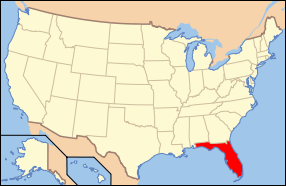Venice Seaboard Air Line Railway Station
|
Venice Seaboard Air Line Railway Station | |
|
| |
  | |
| Location | Venice, Florida |
|---|---|
| Coordinates | 27°6′3″N 82°26′25″W / 27.10083°N 82.44028°WCoordinates: 27°6′3″N 82°26′25″W / 27.10083°N 82.44028°W |
| Architectural style | Mission/Spanish Revival |
| MPS | Venice MPS |
| NRHP Reference # | 89001072[1] |
| Added to NRHP | August 17, 1989 |
The Venice Seaboard Air Line Railway Station (also known as the Venice Depot) is a historic former Seaboard Air Line Railroad depot located at 303 East Venice Avenue in Venice, Florida, U.S.A.. It is currently the southern trailhead of the Legacy Trail, which runs along the railroad's former right of way. It now serves as a hub for bus service operated by Sarasota County Area Transit (SCAT). On August 17, 1989, it was added to the U.S. National Register of Historic Places.
History
In the 1870s, Richard Roberts established a homestead near Roberts Bay. In 1884, he sold a portion of his holdings to Frank Higel. Higel established a citrus operation involving the production of several lines of canned citrus items, and for the next 30 years the Higel family members were boat builders, fishermen, grove caretakers and contractors. Darwin Curry was the first postmaster. The Higel and Curry families chose the name "Venice" for their community post office, located south of Shakett Creek on what is now Portia Street in the unincorporated community of Nokomis.
The Seaboard Air Line (SAL) was the first railroad to expand its network into Sarasota County, Florida, extending tracks first to Sarasota in 1903 and Fruitville in 1905. The SAL extended their network into Venice in 1911, at the instigation of Mrs. Potter ("Bertha") Palmer, whose family had just purchased thousands of acres south of Fruitville and adjacent to the Venice area. The first depot in Venice was located originally at the junction of what is now Tampa and Nokomis Avenues.
In 1925, Dr. Fred H. Albee, a well-known orthopedic surgeon, purchased 2,916 acres (11.80 square km) of land from the Venice-Sarasota Company. Albee had previously developed Nokomis and built its first luxury hotel, known as the Pollyanna Inn. Albee asked John Nolen, a world-renowned city planner, to design a city on his land, but Albee did not have a chance to implement his city plan before he was approached with a proposal from the Brotherhood of Locomotive Engineers to purchase the land in October 1925. The purchase was motivated by a desire by the BLE to increase the union's assets and holdings in the area.[5]
The BLE Realty Corporation was organized to develop the area, and the Venice Company was created to market property. The company retained Nolen to complete a city plan in 1926. Nolen moved the SAL tracks eastward to the present location of the Venice depot. The new depot was designed by the well-known successful New York architectural firm of Walker & Gillette (still extant today under the name Swanke Hayden Connell Architects), who the BLE retained to design most of the new buildings they were planning for Venice. Walker & Gillette designed the depot in harmony with the other structures in Venice, adopting a Mediterranean Revival style then highly popular in Florida due to its warm climate and Spanish heritage. The spare, unornamented exterior yellow stucco surfaces, in combination with the simple arched and blocky volumes gently-sloping red tile roofs seen in the depot building are the hallmarks of this style. The structure of the building under the stucco used a hollow clay tile.
For a town as small as Venice was, the train station was commodious, boasting a 400-foot-long platform, baggage and freight rooms, a prominent tower, extensive arcades spanning the length of the platform, and (as was normal in much of the United States at the time) segregated white and colored waiting rooms. As Venice was a planned city, the large size of the depot can probably be explained by its founders' hopes that it would grow to the point where it would require such a grand reception for prodigious rail service. The total cost of the depot was $47,500. It opened for service on 27 March 1927.
The Venice Seaboard Air Line Depot became an important point of transit for the city over the next forty-five years.[2] It was served by great SCL trains such as the Camellia and the Orange Blossom Special. The station regularly welcomed Kentucky Military Institute students and faculty for annual winter terms, beginning in January 1933. It became the primary point of entry to the city for U.S. Army material and personnel once the Army established an air base in Venice in 1942, during World War II. In 1960s, when passenger rail traffic had become moribund across the USA, the Ringling Bros. and Barnum and Bailey Circus used it for shipping their equipment and operations around the country once they moved to Venice in 1960. Operations were taken over by the new Seaboard Coast Line in 1967 when it was formed from the merger of the SAL and its rival, the Atlantic Coast Line Railway. Passenger service to the station finally ceased on 30 April 1971 with the consolidation of nearly all the nation's passenger trains into the new National Railroad Passenger Corporation (Amtrak), which came into existence the following day, 1 May.

In 1998, Sarasota County acquired the building, which is the last extant railroad depot in its jurisdiction, and local government undertook restoration of the structure, including archaeological excavations.[3] Today the city of Venice has incorporated the grounds of the historic depot into the Venetian Waterway Park, which covers both banks of the Gulf Intracoastal Waterway, bordering the depot's grounds to the west. The SAL tracks have largely been removed and the station now houses the Venice Area Historical Society Museum, along with event space that can be privately rented. Bus service to the area is provided from the arcaded waiting area at the south end of the station. A former red Seaboard Air Line freight car, now restored and used as offices for the Historical Society, stands beyond the station's north end adjacent to a large freestanding wooden deck. A historic marker was installed by the Sarasota County Historical Commissions in 2003.
References
- ↑ National Park Service (2010-07-09). "National Register Information System". National Register of Historic Places. National Park Service.
- ↑ Uzi Baram 2011 “Transformative Transportation: The Early Twentieth-Century Railroad on the Southwest Florida Frontier” International Journal of Historical Archaeology 15(2): 236-253.
- ↑ Uzi Baram, Susan Lynn White and Erin Westfall 2001. Historical Archaeological Investigations of Site #8SO585 in Venice, Florida: The Venice Train Depot (VTD) Excavations of 2001. On file at Sarasota County Historical Resources.
External links
- Sarasota County listings at National Register of Historic Places
- Venice Area History at Venice Area Chamber of Commerce
| Wikimedia Commons has media related to Venice, Florida SAL Depot. |

